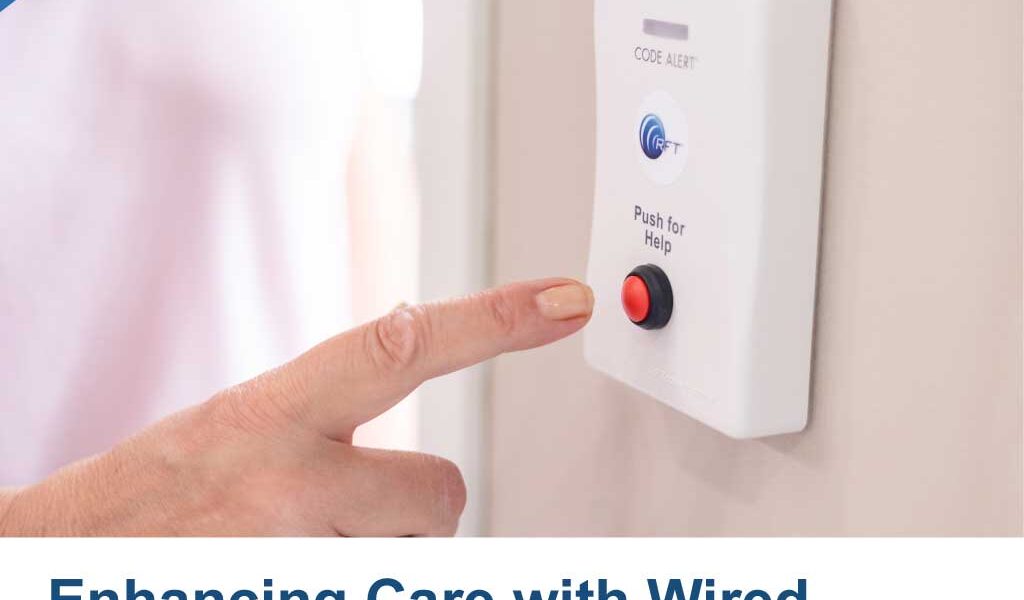Navigating Healthcare Communication: Wired vs. Wireless Nurse Call Systems
Nurse call systems play an integral role in facilitating communication between patients and caregivers and ensuring timely responses to needs and emergencies. Wired or wireless nurse call systems stand out as two distinct approaches, each with its own set of advantages and considerations.
Understanding Wired Nurse Call Systems:
Healthcare and senior living facilities have installed wired nurse call systems for decades. Wired systems typically consist of a network of physical cables connecting bedside units, nurse stations, and other relevant endpoints.
Here are some key aspects of wired nurse call systems:
- Reliability: Wired systems are less prone to interference or signal disruptions compared to their wireless counterparts because physical cables ensure direct connections.
- Security: Wired systems operate within a closed network, so they are perceived as more secure compared to wireless alternatives.
However, wired nurse call systems also present some challenges:
- Flexibility: Installing a wired system is labor-intensive and disruptive, especially in existing facilities where retrofitting is necessary.
- Scalability: Expanding a wired system to accommodate additional endpoints or new wings of a facility may require significant infrastructure modifications and costs.
- Networking: Fixed, pull cord devices are often not connected to a computer-based network with reporting capabilities.
- Cost: Overall cost for wired nurse call systems is more due to the expense of pulling and installing wiring if it is not already present.
Exploring Wireless Nurse Call Systems:
Wireless nurse call systems are a modern, and often preferred, alternative to traditional wired solutions. These systems utilize wireless technology such as radio frequencies or Wi-Fi to establish communication instead of physical cables.
Here are some characteristics of wireless nurse call systems:
- Flexibility: Wireless systems offer flexibility, allowing for quick and hassle-free installation without the need for extensive cabling.
- Scalability: Wireless systems can easily scale to accommodate changing needs and expanding facilities.
- Mobility: Mobile devices can receive alerts and notifications from anywhere within the facility, enabling greater mobility and responsiveness.
- Networking: wireless nurse call systems are often connected to a computer-based network with reporting capabilities.
- Cost: The overall cost for wireless nurse call systems is less due to not having to pull and install wiring.
While wireless nurse call systems offer numerous benefits, they also come with their own set of considerations:
- Reliability: Wireless systems are susceptible to interference from other electronic devices or physical obstacles, potentially impacting signal reliability.
- Battery Dependence: Battery replacement is necessary approximately every year to ensure uninterrupted operation.
Certifications:
It’s important to pay attention to nurse call certifications because states have different requirements. The standard for most hospitals and some senior living systems is UL 1069 wired nurse call systems. RFT has both wired and wireless UL 1069 nurse call systems. RFT’s wireless Quick Response Pro® is UL 1069 certified and managed by CODE ALERT® Enterprise software.
Senior and assisted living facilities in some states require UL 2560 wireless nurse call systems. RFT’s Quick Response® wireless call solution is UL 2560 certified and managed by CODE ALERT® Enterprise software.
Enterprise software has an intuitive user interface to receive and categorize alerts, a facility map view to quickly see the location of alerts, reporting, and a dashboard.
Choosing the Right Solution:
The goal of any nurse call system is to enhance communication and streamline patient care delivery. Healthcare facilities can make informed decisions to meet the evolving needs of their patients and caregivers by understanding the strengths and limitations of wired and wireless solutions.




